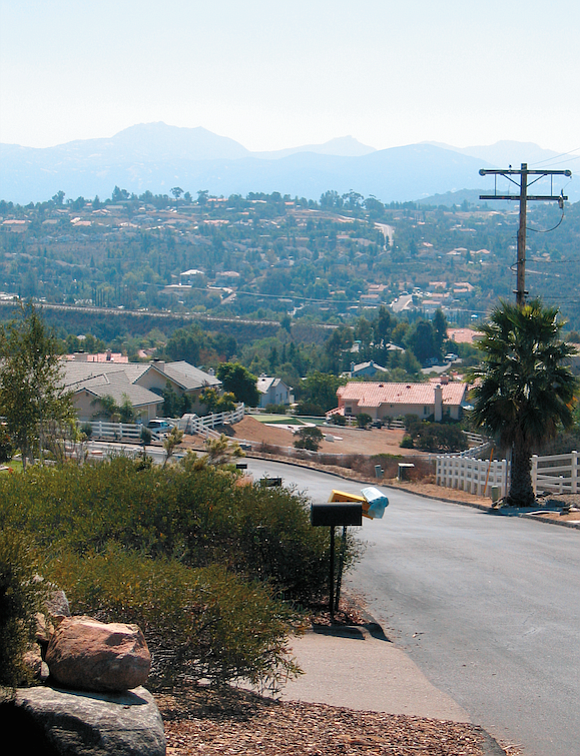 Facebook
Facebook
 X
X
 Instagram
Instagram
 TikTok
TikTok
 Youtube
Youtube

When I moved into Peutz Valley, this deadend, oak-lined community in Alpine, my family consisted of two boys still living at home, craving a country atmosphere. Here we could raise animals and grow a garden, learn the old arts of canning, butchering, milking, and cheese-making. The '70s provided this back-earth movement, and our few neighbors, like my family, immersed themselves in it, regardless of the distance between our homes. We learned the pleasure and the necessity of being good neighbors — we were there to transport trick-or-treaters to houses that sat at the top of steep driveways, when the alternative would be for valley kids to miss out on Halloween. We were willing to repair a roof or raise a barn when Santa Ana winds howled through the valley sending chickens, roofing shingles, and old barn sheet metal flying through the air. We counted on neighbors when there was trouble, enjoyed their company at Christmas and summer gatherings, but for the most part allowed them their privacy.
My private moments were spent dangling my legs off the old bridge that crossed Chocolate Creek. I watched the sycamore branches sway and dreamed poetry of this new world that I had discovered:
And so time passed. My boys grew up, went off to college, married, all stronger for the values learned in this small replica of a working ranch. The two children, now grown, who did not benefit from growing up in Peutz Valley, were now bringing their children to the ranch, taking from it that specialized knowledge — how to trim the hooves of goats, to recognize that this is not just brush that covers our hills, but sage, and deer weed, ceanothus, and a thousand other distinct plants that have their own smell, herbal use, and beauty.
Generations now enjoy a rural community in the middle of this populated county, and they are joined by bicyclists and hikers who abide by the signs that indicate where to park their cars and put their trash. And we, the elderly and younger residents, savor every moment in our secret valley, perhaps made more visible when we talk about our home but especially treasured since the fire that swept through our hills on October 26, 2003.
Yes, we lost homes and animals, ancient oaks and yucca, and saddest of all, we lost a neighbor. The fire did not kill our spirit, but renewed our sense of community. We recognized again the experience of hard times and saw it draw us closer as we worked through the monstrous job of recovery. Like most historical lessons, we learned that it is not place or setting that make a community, but the need for human contact and a sense of belonging.


When I moved into Peutz Valley, this deadend, oak-lined community in Alpine, my family consisted of two boys still living at home, craving a country atmosphere. Here we could raise animals and grow a garden, learn the old arts of canning, butchering, milking, and cheese-making. The '70s provided this back-earth movement, and our few neighbors, like my family, immersed themselves in it, regardless of the distance between our homes. We learned the pleasure and the necessity of being good neighbors — we were there to transport trick-or-treaters to houses that sat at the top of steep driveways, when the alternative would be for valley kids to miss out on Halloween. We were willing to repair a roof or raise a barn when Santa Ana winds howled through the valley sending chickens, roofing shingles, and old barn sheet metal flying through the air. We counted on neighbors when there was trouble, enjoyed their company at Christmas and summer gatherings, but for the most part allowed them their privacy.
My private moments were spent dangling my legs off the old bridge that crossed Chocolate Creek. I watched the sycamore branches sway and dreamed poetry of this new world that I had discovered:
And so time passed. My boys grew up, went off to college, married, all stronger for the values learned in this small replica of a working ranch. The two children, now grown, who did not benefit from growing up in Peutz Valley, were now bringing their children to the ranch, taking from it that specialized knowledge — how to trim the hooves of goats, to recognize that this is not just brush that covers our hills, but sage, and deer weed, ceanothus, and a thousand other distinct plants that have their own smell, herbal use, and beauty.
Generations now enjoy a rural community in the middle of this populated county, and they are joined by bicyclists and hikers who abide by the signs that indicate where to park their cars and put their trash. And we, the elderly and younger residents, savor every moment in our secret valley, perhaps made more visible when we talk about our home but especially treasured since the fire that swept through our hills on October 26, 2003.
Yes, we lost homes and animals, ancient oaks and yucca, and saddest of all, we lost a neighbor. The fire did not kill our spirit, but renewed our sense of community. We recognized again the experience of hard times and saw it draw us closer as we worked through the monstrous job of recovery. Like most historical lessons, we learned that it is not place or setting that make a community, but the need for human contact and a sense of belonging.
Comments